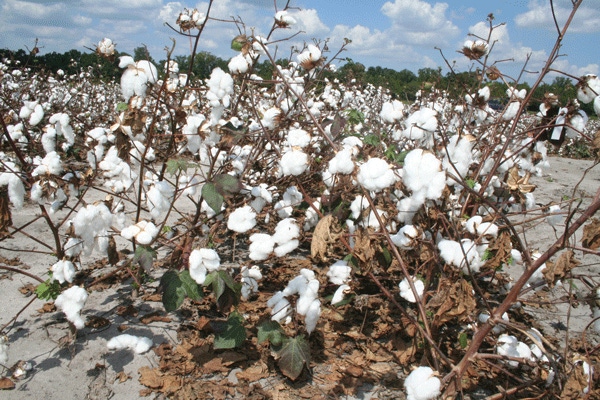
2011 crop acreage battle expected to get intense
• Dollar a pound prices buffed up the crown of King Cotton and just may bring it back to pre-ethanol acreage.• Peanut contracts with more than one five in them seems to have rejuvenated interest in planting that crop.• Corn at $5.50 a bushel is still a money-making proposition for most farmers, especially those in the upper Southeast.
January 12, 2011

The upswing in grain prices over the past few years, fueled by the need for corn for ethanol and by some creative financial investors, has knocked cotton off its throne and put peanuts in a life and death situation for acres in the Southeast.
Will the two traditional crops in the Southeast make a significant comeback in 2011?
Dollar a pound prices buffed up the crown of King Cotton and just may bring it back to pre-ethanol acreage. Likewise, peanut contracts with more than one five in them seems to have rejuvenated interest in planting that crop.
Typically, an increase in cotton acreage in the Southeast means a drop in soybean acreage. That may happen, but at $12 a bushel, it’s hard to understand how or why. Good prices aside, Charles Hall, executive secretary of the North Carolina Soybean Growers Association, says he expects a significant reduction in acreage in the Southeast’s largest soybean producing state.
Corn at $5.50 a bushel is still a money-making proposition for most farmers, especially those in the upper Southeast. With continued public interest in and political pressure on increasing alternative fuel production, the future for corn looks good for the next couple of years.
Worldwide demand for wheat remains good and prices are stable. Though wheat doesn’t directly factor into 2011 planting decisions, it does affect total acreage, because of the opportunities for double-cropping with wheat and barley.
Barley at $4.40 a bushel, or 80 percent of corn futures, combined with double-cropped beans at $12 a bushel, looks like a worthy opponent, especially in the upper Southeast, where cotton and peanut production are a bit more influenced by the weather.
COTTON
December 2011 cotton futures closed recently at 97.96 cents per pound. Prices for this year’s crop, sold in December at the unheard of price of $1.42 a pound. Uncertainty over China’s cotton prices, continued demand for cotton products and the continued weakening of the U.S. dollar have combined to put Southeast growers in a quandary about how much cotton to plant and what crop to replace.
The 2010 crop is mostly already sold and the remainder should be sold when the bales are available. Producers should strongly consider pricing a portion of the 2011 crop. The U.S. will plant more cotton in 2011, says University of Georgia Economist Don Shurley.
Before growers jump to the economic calling of cotton, they should consider the short- and long-term costs of ramping up cotton production or getting into production for the first time.
All, or virtually all, costs will be up in 2011. Fertilizer prices are already projected to jump in response to the high crop prices. Crop insurance will be increased in response to the higher value of cotton and other crops.
Cotton equipment a challenge
Farmers who have been out of the cotton business for a few years are going to find the cost of cotton equipment, both new and used, to be a challenge. New cotton pickers with on-board module builders are going for more than $550,000. Perhaps more significantly, the price of used cotton pickers has gone up significantly, as has the price of custom picking — to pay for the higher investment in equipment.
A consensus among cotton growers and cotton marketing experts is that the recent increase in cotton prices will probably keep the price of 2011 and 2012 cotton crops high. After that, history doesn’t look so promising, but demand for cotton clothing and China’s reluctance to grow fiber over food seem to bode well for U.S. cotton.
After three consecutive years of decline (2007-2009) U.S. cotton acreage increased in 2010. In some areas in the upper Southeast, cotton production fell as much as 50 percent in the three-year period. This type up and down in pricing makes it tough for farmers to make long-term investments in cotton equipment.
PEANUTS
The onset of glyphosate-tolerant cotton and broad scale minimum-tillage systems brought to the Southeast a perfect row crop combination — peanuts and cotton. Though tempered in more recent years by good corn prices and a return to more traditional corn-peanut rotations, cotton and peanuts became staple crops in the late 1990s.
At the turning of the millennium, North Carolina and Virginia produced over 200,000 acres of peanuts. By the end of the first decade of 2000, peanut production in the two states was a scant 78,000 acres. During that same time frame, peanut production in South Carolina climbed from less than 10,000 acres in 2000 to a projected 70,000 acres in 2011.
Like most crops, peanut acreage is driven by dollars. Unlike most crops, peanut acreage can also be driven by family tradition. Despite long-term family ties with peanuts, many growers in the upper Southeast just could not battle ever-increasing costs of production, especially disease management and perpetual uncertainty as to pricing.
In 2011 pricing won’t be an issue. In early December peanut contracts began coming out at better than $500 for runner types and up to $610 for Virginia types ($165-$175 above loan value of the crop).
Unlike cotton and higher acreage crops, peanut acreage will be tightly controlled by the peanut industry — or more accurately the peanut industry will try to control production. Though it seems fairly straight forward — no contract, no peanuts, it historically hasn’t worked like that.
Many peanut growers have not signed these 2011 contracts, which are in some cases $100 per ton better than 2010 contracts. Shellers have to insure there are enough peanuts to meet market demand and growers want to get as much as they can for their crop.
The bottom line is that carryover from the 2010 crop is likely to be in excess of 500,000 tons. That doesn’t exactly inspire buyers to rush out and buy 2011 peanuts that sold for $500-600 per ton, when they can buy cheaper peanuts from the 2010 crop.
A sharp drop in cotton prices in early November influenced some shellers to discontinue offering contracts. However, some shellers see the direct threat to peanut acreage from cotton and continued offering contracts well into December.
2010 crop disappointing
At the end of the proverbial day, buyers hope growers will save enough land to produce enough peanuts to meet market and carryover demands. In the upper Southeast growers painfully remember the 2010 crop, which was over 1,000 pounds per acre less than yields in 2009.
While the high prices may influence some speculators to predict an increase in peanut acreage, that’s not likely to happen because of the high cost of getting into and out of the peanut business. Like cotton, peanuts require some specialized equipment and growers are not likely to invest on what may be a one-time contract offer.
CORN
Corn, soybeans and wheat have been an economically sound planting combination for growers in the Southeast, especially the upper Southeast, for the past few years. Corn prices look to remain fairly stable at $500-$550 for the 2011 crop.
The Southeast has not been a traditional corn production area, and in fact most states in the Southeast are grain deficit, because of large stocks of chickens, cows and hogs.
Nationally, for 2011, projected corn returns are considerably higher than projected soybean returns, suggesting that shifting acres to more corn away from soybeans will increase profits.
For example, in the Midwest, shifting 100 acres from soybeans to corn is projected to increase profits by $13,200 ($132 per acre).
Iowa State University Extension Grain Marketing Specialist Bob Wisner says, “Supplies are on a hair trigger. Any weather problems anywhere, any problems with the soybean crop in South America, for example, and prices are going to react. Any problems with corn and the lack of acreage in 2011 in the U.S., the market will react to that too.”
Wisner, along with most ag economists agree that losing tax credits for ethanol won’t significantly impact on corn prices, because the U.S. has a Federal mandate to produce alternative fuel and ethanol is the most currently accessible way to do this.
In the Southeast, corn acreage won’t likely change much in 2011. The rotational value of the crop, combined with its ease of production, timing of production and high cash value will make it hard for growers to switch to more lucrative crops, like cotton.
SOYBEANS
Forty bushel per acre soybeans and 80 bushel per acre wheat has been a tough double-crop combination to beat for growers in the Southeast in the past few years. The combination of cotton at better than 90 cents a pound, peanuts at $600 per ton and corn at $5.50 per bushel may just push bean acreage down in the Southeast in 2011 — maybe.
Double-crop influence
Another factor working against soybean acreage in the Southeast in 2011 is the lack of available high quality wheat seed. Lacking confidence in wheat quality and subsequently risking high quality docks on pricing, many growers chose to avoid wheat in the fall of 2010. Fewer wheat acres will influence how many late, or double-crop beans are planted.
Nationally, primarily in the Midwest, there will likely be a reduction in soybean acres in 2011.
In the Southeast the picture is not quite so clear. North Carolina is the predominant soybean producing state in the Southeast with about 1.5 million acres annually. It’s not by chance that cotton acreage in the Tar Heel state fell from 2007-2009 and soybean acreage increased significantly in the same time frame.
As North Carolina goes, so goes soybean production in the Southeast. In 2011, it looks like they will follow the national trend on soybean acreage. Nationally, Midwest economists are predicting an acreage decrease for soybeans of 325,000 acres or about five percent below 2010 levels.
In the Southeast, the influence of cotton and to a lesser degree corn may result in slightly more decrease in soybean acreage than is expected nationally.
Having to choose among which of several profitable crops to plant is a good problem for Southeast growers — one they haven’t had the past couple of years.
About the Author(s)
You May Also Like





